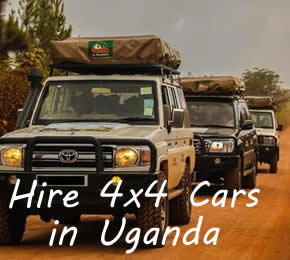Semuliki national park is a protected area in western Uganda found in the Albertine rift valley, named after river Semuliki that flows through its eastern boundary. The park is characterized tropical rain forests, savannah grasslands and a habitat for various wetland habitats.
Semuliki National Park sprawls across the floor of the Semuliki Valley on the remote, western side of the Rwenzori. The park is dominated by the easternmost extension of the great Ituri Forest of the Congo Basin. This is one of Africa’s most ancient and bio-diverse forests; one of the few to survive the last ice age, 12-18,000 years ago.
The Semuliki Valley contains numerous features associated with central rather than eastern Africa. Grass Thatched huts are shaded by West African oil palms; the Semuliki River which forms the international boundary is a miniature version of the Congo River, the forest is home to numerous Central African wildlife species, and the local population includes a Batwa pygmy community that originated from the Ituri. As a result, this park provides a taste of Central Africa without having to leave Uganda.
The park is also home to the famous Sempaya hot springs made up of the male and the female hot springs. The Male Hot Springs is the larger of the two and is characterized by a boiling geyser that shoots hot water and steam high into the air. The water can reach temperatures of up to 103 degrees Celsius (217 degrees Fahrenheit) while the female hot spring is a natural pool of hot water without the geyser-like activity.
This biologically diverse region also provides shelter to a further 120 mammals, including several primate species such as baboons and chimpanzees, as well as elephants and antelopes. There are around 350 species of birds hosted in this forest, more than 300 species of butterflies have been identified, including 46 species of forest swallowtail, together with 235 moth species. Over 435 bird species have been recorded and the checklist includes 35 Guinea-Congo Forest biome bird species, spot-breasted ibis, Hartlaub’s duck, Congo serpent eagle, chestnut flamed goshawk, red thighed sparrowhawk and another 12 species with extremely little distribution are spotted like the western bronze-napped pigeon.
In 1932, Semuliki Game reserve was created and later in 1993 it was upgraded to a national park covers an area of about 220 square kilometers (85 square miles).
HOW TO GET TO THE PARK
By air: You can take a flight from Entebbe airport or Kajjansi air strip to Kasese or Semuliki airstrips that are closest to the parks. These services are provided by companies like Eagle air. You can as well contact your tour operator for a smooth planning of your holiday.
By Road: By Road: you can take a taxi, private car hire, or a guided tour from Kampala or other major cities in Uganda. The journey from Kampala to Semuliki National Park takes approximately 5-6 hours, depending on the road conditions. The route usually involves driving west to Fort Portal town and then proceeding to the park. You can use public transportation. From Kampala, take a bus or taxi to Fort Portal, which is the nearest major town to Semuliki National Park. From Fort Portal, you can hire a taxi or private car to take you to the park entrance.
WHAT TO DO IN SEMULIKI NATIONAL PARK
Wildlife Safari: Embark on a thrilling wildlife safari to explore the park’s diverse ecosystems. Take a guided game drive through the park’s savannah grasslands, where you may spot various wildlife species such as elephants, buffalos, leopards, and Ugandan kobs.
Birdwatching: Semuliki Park is a paradise for birdwatchers, boasting over 400 bird species, including rare and endemic birds. Don’t miss the opportunity to go bird watching along the park’s trails and near the Semuliki River to observe magnificent birds like the shoebill stork, African grey parrots, and hornbills.
Hot Springs Visit: The park is famous for its hot springs, particularly the Sempaya Hot Springs. Witness the bubbling hot water as it spurts from the ground, forming natural geysers. There are two springs, the “male” and “female,” each with its unique characteristics and cultural significance.
Nature Walks and Hiking: Explore the park’s lush rainforests on foot by taking guided nature walks or hiking trails. Discover the park’s unique flora, medicinal plants, and diverse wildlife up close. The Kirumia Trail is a popular option, leading you through the heart of the forest.
Cultural Encounters: Interact with the local communities living near Semuliki Park, such as the Batwa pygmies. Engage in cultural activities, traditional dances, and learn about their way of life. It’s an excellent opportunity to gain insight into the region’s rich cultural heritage.
River Safari: Take a boat safari along the Semuliki River, which offers a different perspective of the park’s ecosystem. Enjoy the tranquil surroundings, spot hippos, crocodiles, and various bird species along the riverbanks.
Camping and Accommodation: Semuliki Park offers camping facilities for those who want to immerse themselves in nature. Alternatively, you can stay in lodges or guesthouses located nearby for a comfortable and convenient stay.
WHAT TO SEE IN THE PARK
Semuliki Wildlife: The park is home to diverse wildlife, including mammals, reptiles, and primates. Look out for elephants, buffalos, Uganda kobs, chimpanzees, red-tailed monkeys, and several species of forest antelopes.
Sempaya Hot Springs: Visit the Sempaya Hot Springs, where you can witness hot water shooting up from the ground. The “male” spring, known as Bitente, can reach temperatures of up to 103°C (217°F), while the “female” spring, Nyasimbi, offers a more moderate temperature. These hot springs are not only intriguing but also have cultural significance for the local communities.
Bird Watching: Semuliki National Park is a haven for birdwatchers. With over 400 bird species recorded, including the iconic and rare shoebill stork, you can enjoy exceptional birding opportunities. Keep an eye out for African grey parrots, yellow-throated cuckoos, white-crested hornbills, and many more colorful and unique species.
Nature Walks and Hiking: Explore the park’s dense rainforests and stunning landscapes on foot. Guided nature walks and hiking trails provide opportunities to encounter diverse flora, including towering trees, orchids, and medicinal plants. The Kirumia Trail is particularly popular, leading you deep into the heart of the forest.
Cultural Encounters: Engage with the local communities, such as the Batwa pygmies, who have a rich cultural heritage. Learn about their traditional way of life, participate in dances, and listen to their stories. This cultural experience offers a unique glimpse into the region’s history and traditions.
River Safari: Take a boat safari along the Semuliki River to observe wildlife and enjoy the serene atmosphere. Look out for hippos, crocodiles, and various bird species that inhabit the riverbanks.
Scenic Views: Semuliki Park boasts breathtaking scenery, including lush rainforests, rolling hills, and the dramatic Rwenzori Mountains in the backdrop. Enjoy the panoramic views and take in the natural beauty of the park.
Make sure to plan your visit ahead of time, consider hiring a knowledgeable guide, and follow park regulations for a safe and memorable experience in Semuliki National Park.
BEST TIME TO VISIT SEMULIKI NATIONAL PARK
The best time to visit ultimately depends on your choice of animals you want to see. For those interested in bird watching, March to May is best to witness the migratory birds from Europe and the wet season as well is suitable for observing breeding patterns of birds.
The other land animals are more visible during the dry seasons due to the dry grasses and since many animals gather around water sources and many parts of the park are more accessible during this time. However, it is important to note that the park is characterized by a tropical rain forest and it can rain even during the dry seasons.
ACCOMMODATION FACILITIES IN THE PARK
Semuliki Safari Lodge: This luxury lodge is located within the Semuliki Wildlife Reserve and offers comfortable and spacious rooms with stunning views of the surrounding landscape. The lodge provides a range of amenities, including a restaurant, bar, swimming pool, and spa facilities.
Ntoroko Game Lodge: Situated on the shores of Lake Albert, Ntoroko Game Lodge offers a tranquil setting and panoramic views of the lake and surrounding savannah. The lodge features well-appointed rooms, a restaurant serving both international and local cuisine, and a bar.
Kirumia Guesthouse: Run by the Uganda Wildlife Authority, Kirumia Guesthouse is a budget-friendly option located within Semuliki National Park. The guesthouse offers basic but comfortable accommodation with en-suite bathrooms and meals can be arranged upon request.
Fort Murchison Lodge: Although located a bit further from Semuliki National Park, Fort Murchison Lodge provides a beautiful setting on the banks of the Nile River. The lodge offers various accommodation options, including tents and cottages, and amenities such as a restaurant, bar, and swimming pool.
Budget Camping: For those seeking a more adventurous experience, camping is permitted in Semuliki National Park. You can bring your camping gear and set up camp in designated areas within the park. However, make sure to check with the Uganda Wildlife Authority for regulations and safety guidelines.


